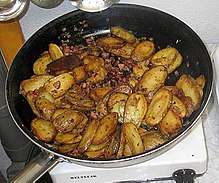European cuisine
European or western cuisine is the cuisines of Europe[1] and other Western countries,[2] including the cuisines brought to other countries by European settlers and colonists. Sometimes the term "European", or more specifically "continental" cuisine, is used to refer more strictly to the cuisine of the western parts of mainland Europe.
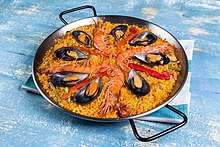
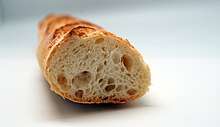
East Asians contrast Western cuisine with Asian styles of cooking,[3] the way Westerners refer to the varied cuisines of East Asia as Asian cuisine.

The cuisines of Western countries are diverse, although there are common characteristics that distinguish them from those of other regions.[4] Compared with traditional cooking of East Asia, meat is more prominent and substantial in serving size.[5] Steak and cutlet in particular are common dishes across the West. Western cuisines also emphasize grape wine and sauces as condiments, seasonings, or accompaniments (in part due to the difficulty of seasonings penetrating the often larger pieces of meat used in Western cooking). Many dairy products are utilised in cooking.[6] There are hundreds of varieties of cheese and other fermented milk products. White wheat-flour bread has long been the prestige starch, but historically, most people ate bread, flatcakes, or porridge made from rye, spelt, barley, and oats.[7][8] The better-off also made pasta, dumplings and pastries. The potato has become a major starch plant in the diet of Europeans and their diaspora since the European colonisation of the Americas. Maize is much less common in most European diets than it is in the Americas; however, corn meal (polenta or mămăligă) is a major part of the cuisine of Italy and the Balkans. Although flatbreads (especially with toppings such as pizza or tarte flambée) and rice are eaten in Europe, they are only staple foods in limited areas, particularly in Southern Europe. Salads (cold dishes with uncooked or cooked vegetables with sauce) are an integral part of European cuisine.
Formal European dinners are served in distinct courses. European presentation evolved from service à la française, or bringing multiple dishes to the table at once, into service à la russe, where dishes are presented sequentially. Usually, cold, hot and savoury, and sweet dishes are served strictly separately in this order, as hors d'oeuvre (appetizer) or soup, as entrée and main course, and as dessert. Dishes that are both sweet and savoury were common earlier in ancient Roman cuisine, but are today uncommon, with sweet dishes being served only as dessert. A service where the guests are free to take food by themselves is termed a buffet, and is usually restricted to parties or holidays. Nevertheless, guests are expected to follow the same pattern.
Historically, European cuisine has been developed in the European royal and noble courts. European nobility was usually arms-bearing and lived in separate manors in the countryside. The knife was the primary eating implement (cutlery), and eating steaks and other foods that require cutting followed. In contrast in the Sinosphere, the ruling class were the court officials, who had their food cut ready to eat in the kitchen, to be eaten with chopsticks. The knife was supplanted by the spoon for soups, while the fork was introduced later in the early modern period, ca. 16th century. Today, most dishes are intended to be eaten with cutlery and only a few finger foods can be eaten with the hands in polite company.
Central European cuisines
All of these countries have their specialities.[9] Austria is famous for their Wiener Schnitzel - a breaded veal cutlet served with a slice of lemon, the Czech Republic for their world renowned beers. Germany for their world-famous wursts, Hungary for their goulash. Slovakia is famous for their gnocchi-like Halusky pasta. Slovenia for their German and Italian influenced cuisine, Poland for their world-famous Pierogis which are a cross between a Ravioli and an Empanada. Liechtenstein and German speaking Switzerland are famous for their Rösti and French speaking Switzerland for their fondue and Raclettes.
- Ashkenazi cuisine





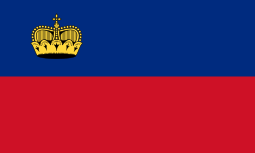



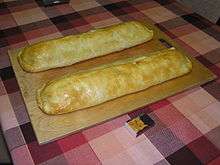 Austrian strudel
Austrian strudel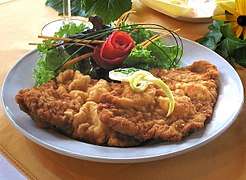 Austrian Wiener Schnitzel
Austrian Wiener Schnitzel- Czech Svíčková
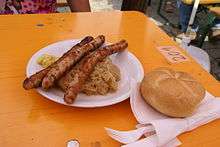 German Bratwurst with sauerkraut
German Bratwurst with sauerkraut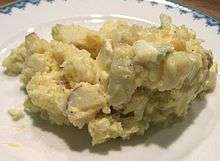 German potato salad
German potato salad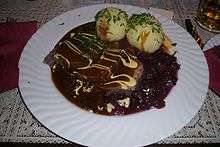 German Sauerbraten
German Sauerbraten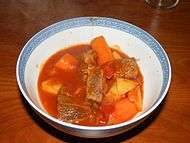 Hungarian gulyás
Hungarian gulyás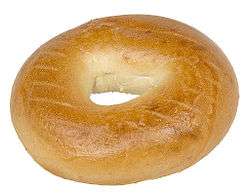 Polish bagel
Polish bagel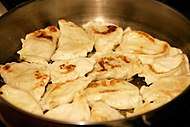 Polish pierogi
Polish pierogi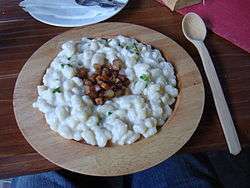 Slovakian Bryndzové halušky
Slovakian Bryndzové halušky- Slovakian Skalický trdelník
- Slovenian Prekmurska gibanica
- Slovenian žganci
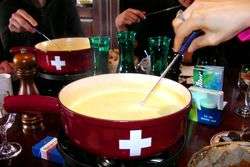 Swiss fondue
Swiss fondue
Eastern European/Caucasian cuisines






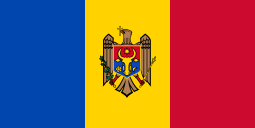


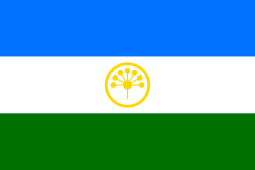
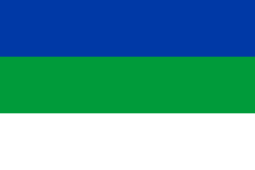
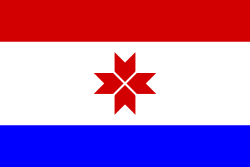
.png)
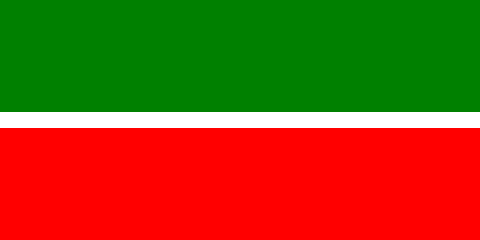
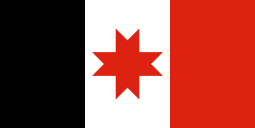
- Yamal cuisine


 Armenian khorovats
Armenian khorovats- Azerbaijani plov
 Bashkir and Tatar Öçpoçmaq
Bashkir and Tatar Öçpoçmaq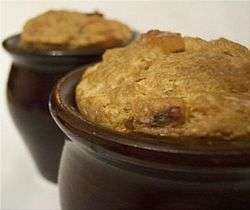 Belarusian potato babka
Belarusian potato babka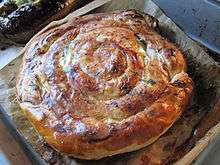 Bulgarian Banitsa
Bulgarian Banitsa- Bulgarian Yogurt (Kiselo mlyako)
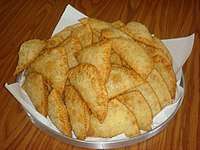 Circassian Haliva
Circassian Haliva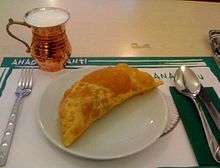 Crimean Tatar chiburekki
Crimean Tatar chiburekki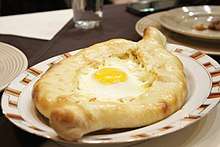 Georgian khachapuri
Georgian khachapuri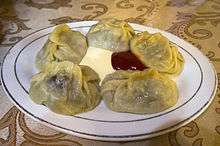 Kazakh manti
Kazakh manti- Russian pirozhki
 Russian Olivier salad
Russian Olivier salad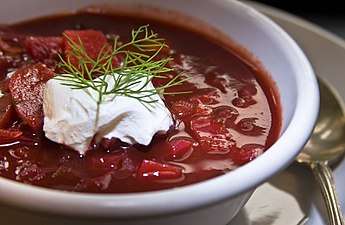 Ukrainian borscht
Ukrainian borscht
Northern European cuisines


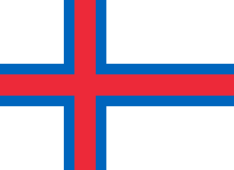

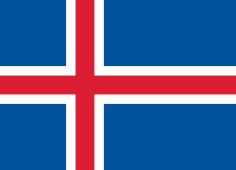




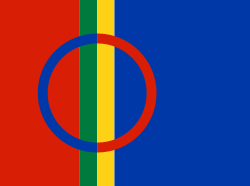

- Danish bøfsandwich
 Danish stegt flæsk
Danish stegt flæsk- Estonian kama dessert
 Faroese tvøst og spik
Faroese tvøst og spik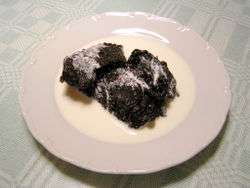 Finnish mämmi
Finnish mämmi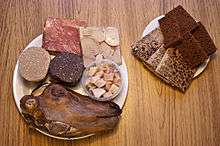 Icelandic Þorramatur
Icelandic Þorramatur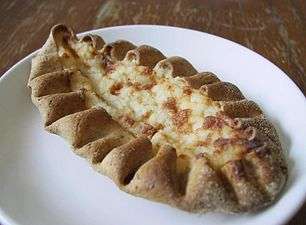
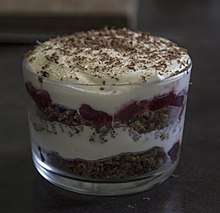 Latvian Layered Rye Bread
Latvian Layered Rye Bread- Lithuanian cepelinai
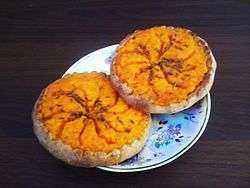 Livonian Sklandrausis
Livonian Sklandrausis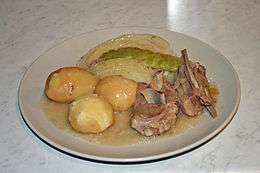 Norwegian fårikål
Norwegian fårikål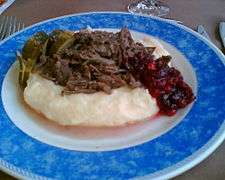 Sami Sautéed reindeer
Sami Sautéed reindeer.jpg) Swedish smörgåsbord
Swedish smörgåsbord- Swedish surströmming
Southern European cuisines



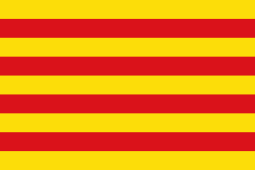
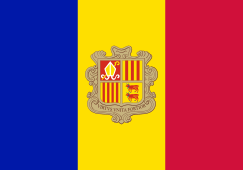


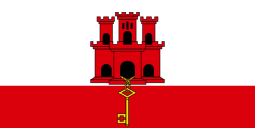

- Ancient Greek cuisine
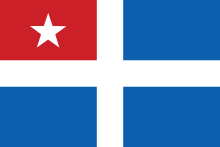
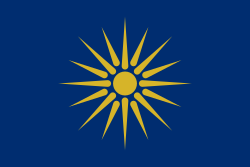


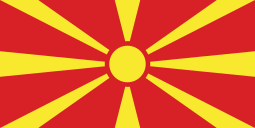
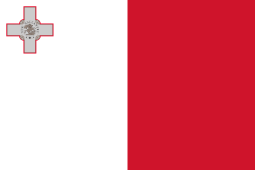
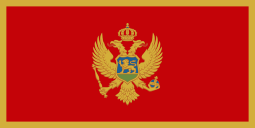
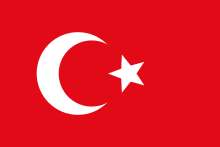

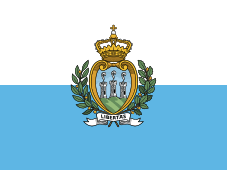



 Albanian flia
Albanian flia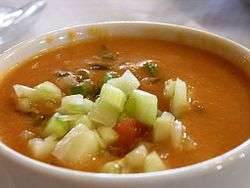 Andalusian gazpacho
Andalusian gazpacho Balearic ensaïmades
Balearic ensaïmades- Bosnian ćevapi
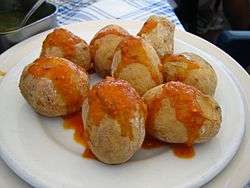
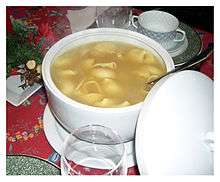 Catalan escudella i carn d'olla
Catalan escudella i carn d'olla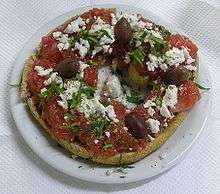 Cretan Dakos
Cretan Dakos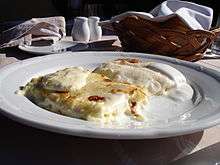 Croatian Zagorski štrukli
Croatian Zagorski štrukli Cypriot souvla
Cypriot souvla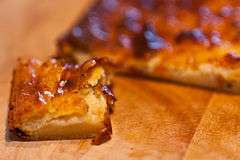 Gibraltarian calentita
Gibraltarian calentita- Greek gyros
- Italian polenta with rabbit
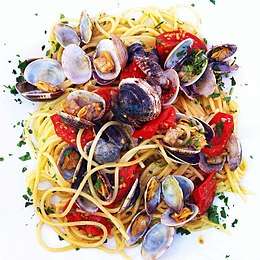 Italian spaghetti alle vongole
Italian spaghetti alle vongole_(3).jpg) Macedonian Tavče gravče
Macedonian Tavče gravče.jpg) Maltese kusksu
Maltese kusksu.jpg) Montenegrin njeguški pršut
Montenegrin njeguški pršut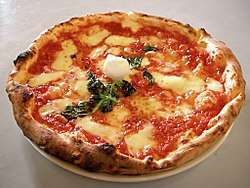 Neapolitan pizza
Neapolitan pizza- Portuguese Cozido à portuguesa
- Portuguese Francesinha
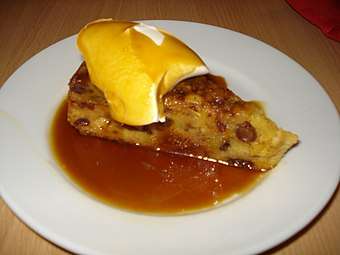 Sammarinese Bustrengo
Sammarinese Bustrengo Sardinian pane carasau
Sardinian pane carasau- Serbian Pljeskavica
.jpg) Sicilian cannoli
Sicilian cannoli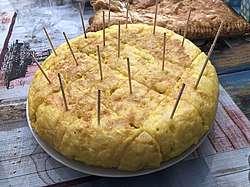
- Spanish tapas
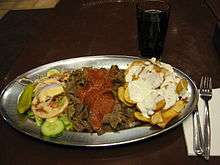 Turkish doner kebab
Turkish doner kebab- Turkish Imam Bayildi
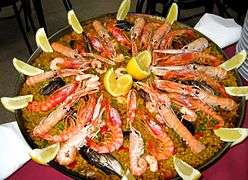 Valencian paella
Valencian paella Venetian carpaccio
Venetian carpaccio
Western European cuisines
.svg.png)




- Haute cuisine
- Cuisine classique
- Nouvelle cuisine

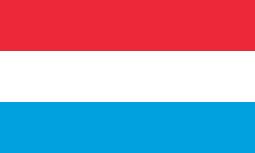
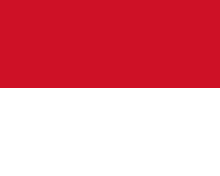
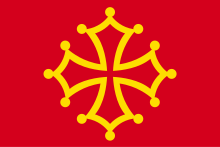
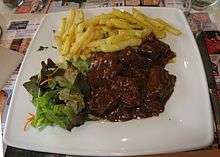 Belgian carbonnade flamande
Belgian carbonnade flamande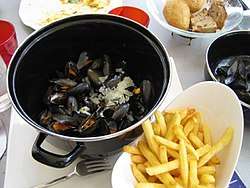 Belgian moules frites
Belgian moules frites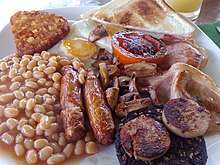 British full breakfast
British full breakfast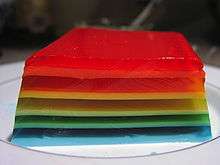 British jelly
British jelly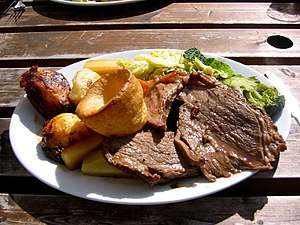 British Sunday roast
British Sunday roast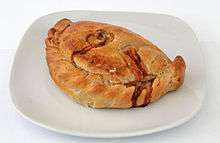 Cornish pasty
Cornish pasty Corsican fritelli
Corsican fritelli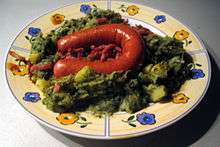 Dutch Boerenkoolstamppot with rookworst
Dutch Boerenkoolstamppot with rookworst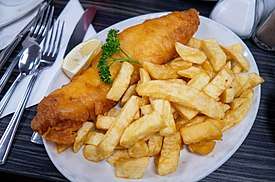 English fish and chips
English fish and chips English shepherd's pie
English shepherd's pie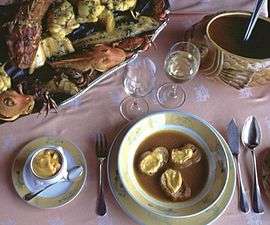 French Bouillabaisse
French Bouillabaisse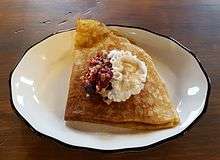 French crêpe
French crêpe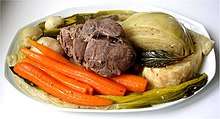 French pot-au-feu
French pot-au-feu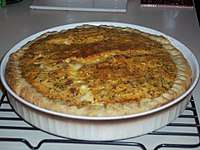 French quiche lorraine
French quiche lorraine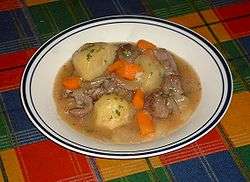
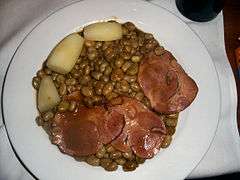 Luxembourgian Judd mat Gaardebounen
Luxembourgian Judd mat Gaardebounen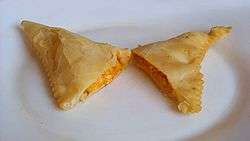 Monégasque Barbajuan
Monégasque Barbajuan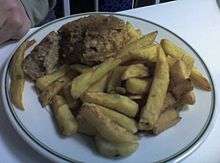 Northern Irish pastie supper
Northern Irish pastie supper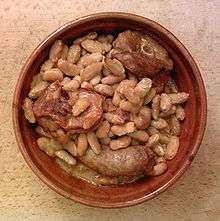 Occitan cassoulet
Occitan cassoulet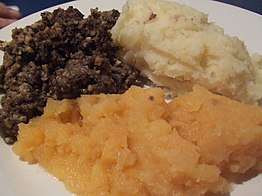
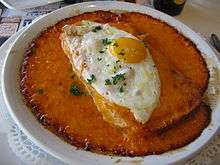
References
- Culinary Cultures of Europe: Identity, Diversity and Dialogue. Council of Europe.
- "European Cuisine." Europeword.com. Accessed July 2011.
- Leung Man-tao (12 February 2007). "Eating and Cultural Stereotypes". Eat and Travel Weekly. No. 312. Hong Kong: Next Media Limited. p. 76.
- Kwan Shuk-yan (1988). Selected Occidental Cookeries and Delicacies, p. 23. Hong Kong: Food Paradise Pub. Co.
- Lin Ch'ing (1977). First Steps to European Cooking, p. 5. Hong Kong: Wan Li Pub. Co.
- Kwan Shuk-yan, pg 26
- Alfio Cortonesi, "Self-sufficiency and the Market: Rural and Urban Diet in the Middle Ages", in Jean-Louis Flandrin, Massimo Montanari, Food: A Culinary History from Antiquity to the Present, 1999, ISBN 0231111541, p. 268ff
- Michel Morineau, "Growing without Knowing Why: Production, Demographics, and Diet", in Jean-Louis Flandrin, Massimo Montanari, Food: A Culinary History from Antiquity to the Present, 1999, ISBN 0231111541, p. 380ff
- "Cuisine from Central Europe". Visit Europe. Archived from the original on 23 August 2012. Retrieved 1 July 2013.
Further reading
- Albala, Ken (2003). Food in Early Modern Europe. Greenwood Publishing Group. ISBN 0313319626. Retrieved 6 June 2017.
- R & R Publishing (2005). European Cuisine: The Best in European Food. Cpg Incorporated. ISBN 1740225279. Retrieved 6 June 2017.
